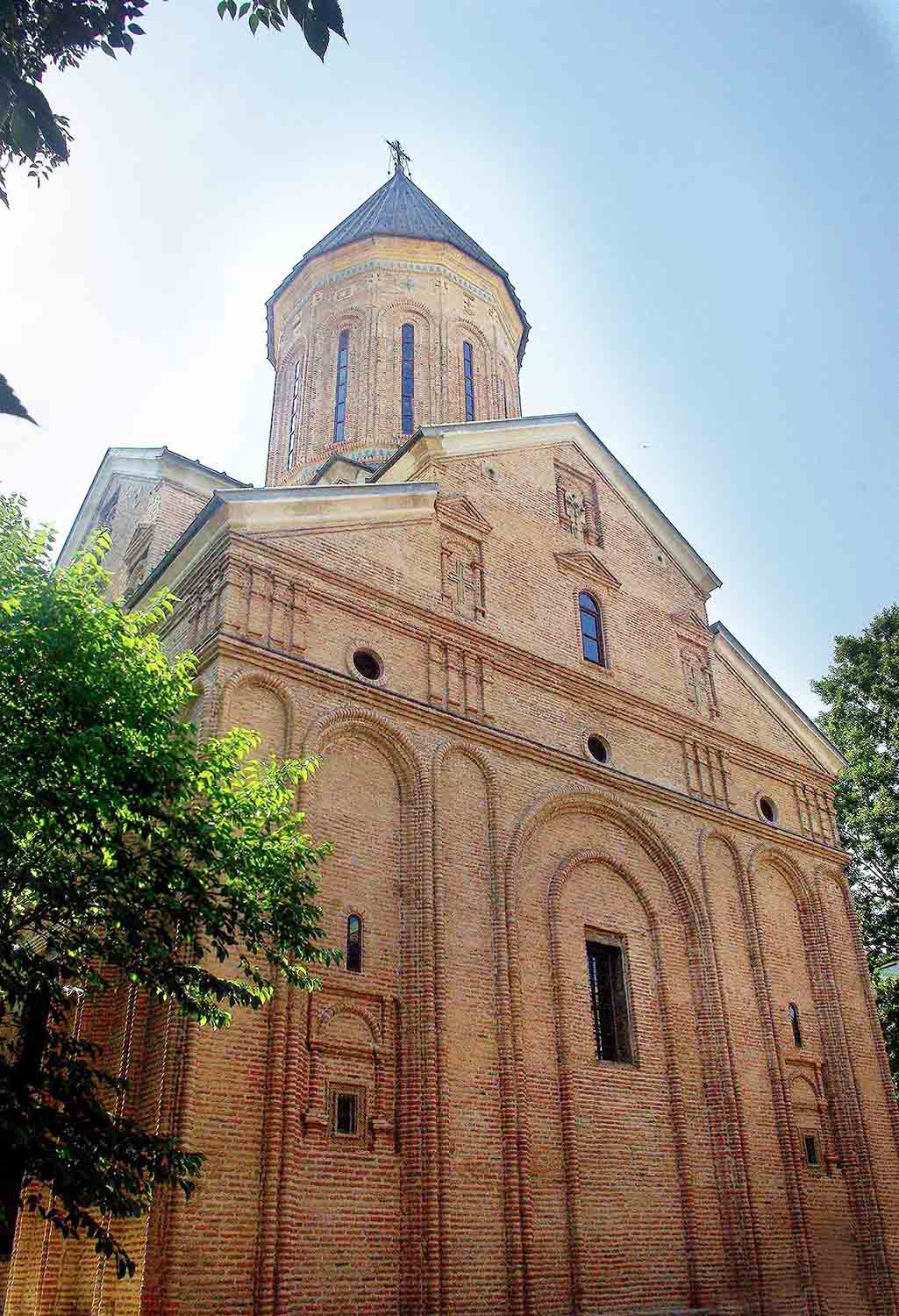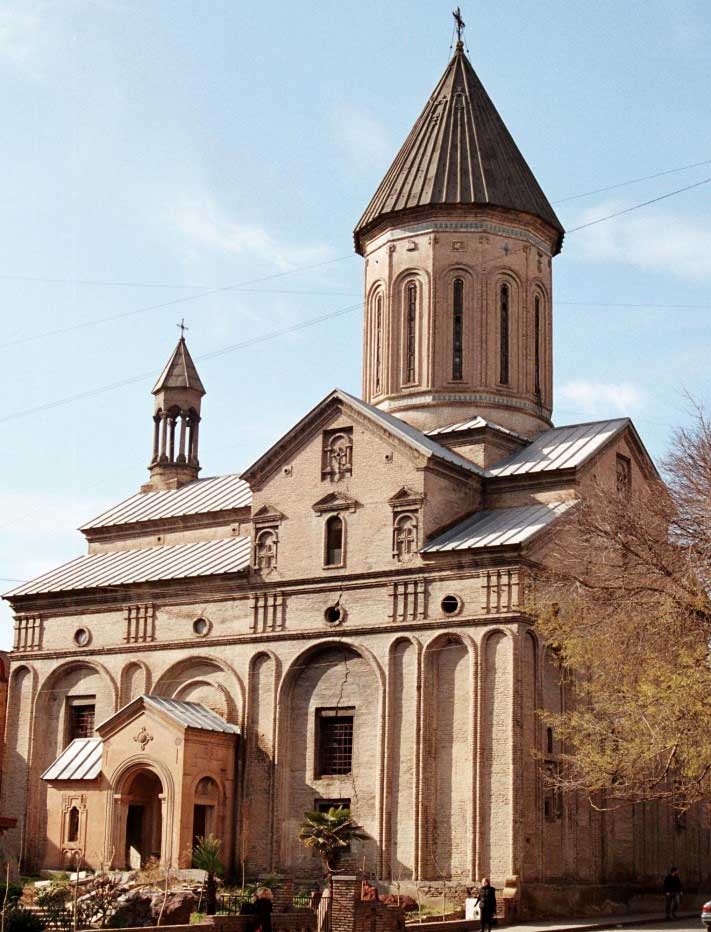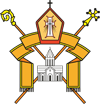NORASHEN SOURB ASTVATSATSIN CHURCH (HOLY MOTHER OF GOD) IN TBILISI
THE CHURCH WAS ESTABLISHED IN 1467, IN SOME SOURCES MENTIONED IN 1507. CURRENTLY, THE CHURCH IS STANDING BUT IN A DAMAGED CONDITION.
Establishment and reconstructions: Norashen Sourb Astvatsatsin church (Holy Mother of God) is one of the famous and revered Armenian churches of Old Tiflis. It is located in the vicinity of Meidan Square in Tbilisi, at the current Kote Abkhazi Street (former Leselidze Street) № 41, neighboring the Georgian Primate’s Residence Sioni Cathedral and Greek Jvaris Mama churches.
In terms of the name Norashen, the church was mentioned in all its historical chronicles as Sourb Astvatsatsin (Holy Mother of God) and was never referred to as "Avetyats Sourb Astvatsatsin", as P. Muradyan has mistakenly written[1] Probably, this misunderstanding was the basis for some Georgian clergymen to call the building the Georgian Khareba (translated: Avetyats (Promised) church, which they tried to consecrate on February 15, 1995, according to the rite of the Georgian church.
According to the record of the church's establishment, it was built in 1507[2]. Norashen Sourb Astvatsatsin church was renovated at different times, both through the efforts of the Armenian population of Tbilisi and thanks to the contributions of a number of benefactors. Particularly, the church was renovated in 1650, 1795, 1808, 1830-1835, 1857, and 1897, and there were certainly renovations later as well.
In 1650 the church was thoroughly renovated with the funds of famous benefactor Khoja Nazar from Jugha[3]. Norashen church was heavily damaged and destroyed in 1795, during the conquest of Agha-Mohammed Khan. Moreover, the destruction was so great that the community of the Norashen church in the person of Hovsep Khatin (he was the father of famous envoy Rafael Dinbekiants) appealed to the Armenian community in Madras with a request to organize a donation to repair the church. The note of debt given by Hovsep, by which he had to hand over the money to the elder of the Norashen church, Ter Arakel Shmavonyan, has also been preserved[4].
The next renovation of the Norashen Sourb Astvatsatsin church was implemented between 1830 and 1835, during which approximately 11,563 rubles were spent[5]. After that renovation, in 1837, the church was described by Egnati Ioseliani, who mentioned it as the fourth Armenian church[6]. In 1899 the total amount of internal repairs was 1154 rubles[7].
Like other Armenian churches in Tbilisi, Norashen also has not escaped the attention of many travelers who visited Tbilisi. In 1673 the French traveler Jean Chardin listed Norashen Sourb Astvatsatsin church among the operating Armenian churches and mentioned. "Norashen or New construction"[8]. In 1817 Italian A. Negri visited Tbilisi, and in 1824-30, his compatriot M. Medici also mentioned the Armenian churches of the city, listing Norashen Sourb Astvatsatsin church among them[9]. Thus, foreign travelers also clearly mentioned the Armenian origin of Norashen.
Architecture: Norashen Sourb Astvatsatsin church with its architectural design belongs to the type of domed basilica structures. The prayer hall (width and length ratio 1:1,2) is divided into three vaulted naves by two pairs of powerful cylindrical pillars (1.55 m in diameter). The dome of the building is placed on the eastern pillars and the corners of the high altar. Sacristies are rectangular without apses (tabernacles). On the western facade, a light, columned belfry rises on a pitched roof[10]. The frescoes of the church are the work of Hovnathanyans.
Economic situation: A number of archival documents provide information about the economic situation of the Norashen church. The register of income and expenditure accounts of the church in 1795-1807 are worth mentioning[11]. In 1837, a list of movable and immovable property of the Norashen church was compiled, in which there are many precious ornaments, jars, printed Gospels, etc.[12]. The two manuscripts mentioned in the 1899 inventory are also worth mentioning: the Gospel and the Tagharan[13].
Clergy: As for the clergy of Norashen, the information pieces about them are numerous. At the end of the 18th century, Rev. Father Hakob, the church’s member of the Brotherhood, was one of the well-known priests in Tbilisi[14]. Rev. Fathers Gevorg Ter-Aharonyan and Harutyun Ter-Sahakyan were among the church’s members of the Brotherhood in the 20s of the 19th century[15]. At the beginning of the 20th century, Rev. Fathers Gevorg Terteriants, Davit Girgidyants, Tadevos Yervandyans, and Sargis Shioyants served as priests at the church[16].
Church-parochial schools: Norashen church’s Parish School for males was probably opened in 1858. In 1873 the school had 4 teachers and 38 students[17].
One of the oldest and most famous schools opened for Armenian girls was Norashen's Saint Mariamian School for females. It was founded in 1866 by prominent Armenian pedagogue Khoren Stepane[18]. In 1917 Norashen church’s school had secondary level.
Soviet and post-Soviet period: Norashen Sourb Astvatsatsin church, like other Armenian churches in Tbilisi, was in danger of being closed because of the anti-religious policy in the early years of the Soviet Union. In this regard, on June 24, 1925, the members of the Norashen Church Council sent a statement to the Armenian Diocesan Church Council of Georgia: “Norashen church is in danger. In order to widen the street, the city executive committee wants to completely demolish the eastern wall of the church, destroying the altars, the sanctuary...”[19]. On July 8 of the same year, the Church Council of Norashen again appeals to the Armenian Diocesan Church Council of Georgia with the request to release the church from the danger of demolition[20]. As a result, on December 22, 1933, the church closed[21]. In 1972, the scientific library of the Academy of Sciences of the Georgian SSR was located in the church[22].
In May 2008, the Georgian Orthodox Church decided to build a metal fence to enclose the St Norashen Armenian church and its surrounding area, including religious elements characteristic of the Georgian Orthodox Church. The Armenian Diocese in Georgia expressed its concern on that occasion, but in vain[23]. In 2014, the Georgian National Agency for Cultural Heritage Preservation issued a certificate of permission for the implementation of church renovation works. The renovation works were carried out with the financial support of Georgia's Foundation for the Preservation of Historical Monuments. In 2015-2016, urgent engineering and constructive restoration works were carried out in order to strengthen the Norashen church. The dome, facade, and wall of the temple were processed with the high-pressure sand jet method. New doors and windows were installed, and tombstones were brought back to the church.
[1] See P. Muradyan, Armenian Epigraphy of Georgia, Yerevan, 1988, p. 76; Armenian Churches of Old Tiflis, p. 39:
[2] P. Muradyan, Armenian Churches of Old Tiflis, St. Etchmiadzin, 2009, p. 45:
[3] "Ararat", 1850, I year, № 4, September 23, p. 53:
[4] P. Chobanyan, Armenian-Russian-Georgian relations in the second half of the 18th century, St. Etchmiadzin, 2006, p. 111:
[5] NAA, ֆ. 53, ց. 1, գ. 2637, թ. 15-ի շրջ.-16:
[6] L. Melikset-Bek, Georgian sources about Armenia and the Armenians, Vol. 3, Yerevan, 1955, p. 266:
[7] NAA, ֆ. 53, ց. 1, գ. 3399, թ. 2, See also "Echmiadzin", 2010/7, p. 76-77:
[8] P. Muradyan, see previously mentioned work, p. 312:
[9] NAA, ֆ. 469, ց. 14, գ. 329, թ. 11,:
[10] M. Hasratyan, The architecture of the Armenian churches of Tbilisi, “Etchmiadzin”. 2009/6, p. 74:
[11] ՄՄ, Կ/դ, թղթ. 6, վավ. 72:
[12] NAA, ֆ. 56, ց. 6, գ. 39, թ. 36-40:
[13] NAA, ֆ. 53, ց. 1, գ. 1219, թ. 186-189:
[14] MM, A. Yeritsian’s archive, paper. 159, doc. 112 a. See also MM, N. Ashtarakets’ archive paper 164b, doc. 945:
[15] NAA, ֆ. 35, ց. 1, գ. 745, թ. 11-ի շրջ.:
[16] NAA, ֆ. 53, ց. 1, գ. 335, թ. 115-116:
[17] S. Khudoyan, Eastern Armenian schools in 1830-1920, Yerevan, 1987, p. 592-593:
[18] S. Khudoyan, in the same place, p. 591:
[19] NAA, ֆ. 148, ց. 1, գ. 12, թ. 2 և շրջ.:
[20] NAA, ֆ. 148, ց. 1, գ. 12, թ. 3 և շրջ., See also "Echmiadzin", 2010/7, p. 83-84:
[21] NAA, ֆ. 148, ց. 1, գ. 24, թ. 1:
[22] NAA, ֆ. 469, ց. 14, գ. 329, թ. 2:
[23] "Echmiadzin", 2008/10, p. 138-139:
 Հայերեն
Հայերեն  ქართული
ქართული  English
English  Русский
Русский 



